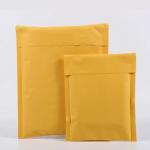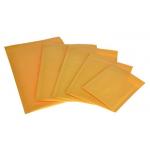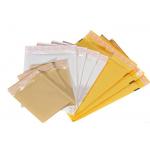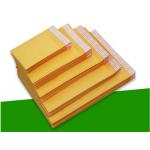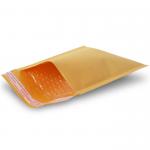| Patterned Blue Kraft Bubble Mailers 215x260mm #E Acid Resistant
Bubble Wrap Packaging Envelopes | | | | Speciallity | | At room temperature, it is insoluble in general solvents, but it
can swell in fatty hydrocarbons, aromatic hydrocarbons and
halogenated hydrocarbons for long time, and it is slightly soluble
in toluene and acetic acid when it is above 70 degrees. | | | | Brief Introduction | Kraft bubble mailers
Kraft bubble mailers or kraft is paper or paperboard (cardboard)
produced from chemical pulp produced in the kraft process.
Sack Kraft bubble mailers, or just sack paper, is a porous Kraft
bubble mailers with high elasticity and high tear resistance,
designed for packaging products with high demands for strength and
durability.
Pulp produced by the kraft process is stronger than that made by
other pulping processes; acidic sulfite processes degrade cellulose
more, leading to weaker fibers, and mechanical pulping processes
leave most of the lignin with the fibers, whereas kraft pulping
removes most of the lignin present originally in the wood. Low
lignin is important to the resulting strength of the paper, as the
hydrophobic nature of lignin interferes with the formation of the
hydrogen bonds between cellulose (and hemicellulose) in the fibers.
Kraft pulp is darker than other wood pulps, but it can be bleached
to make very white pulp. Fully bleached kraft pulp is used to make
high quality paper where strength, whiteness and resistance to
yellowing are important. | | | | Data Sheet | | Materials Classification : | PE | | Melting Point : | 160~170℃ | | Working Temperature : | -100°C~+100°C | | Material Density : | 0.925g/cm³ | | Conventional Size : | 215x260mm #E | | Sample Color : | Coral | | Basic Material : | Co-extruded | | Protruding Characteristics : | Acid Resistant | | Application Industry : | Shopping | | Shape Style : | Automatic Packaging Film | | | | | | | Related Picture | | | | | | Materials introduction | The co extrusion film is applied to pure milk bags, express bags
and metal protective films. It is characterized by good tensile
properties and good surface brightness.
In the process of thin film, a kind of raw material is extruded
into another kind of film which has been made, or the different
kinds of films have been bonded together to form a multilayer film,
which is called composite film. Most of the material of the
composite film is plastic, but it can also be made of paper, metal
foil (usually aluminum) or fabric. The basic requirement of
composite film is good bonding between the layers to ensure the
overall mechanical properties of the packaging. |
|
